A Tale of a Torn Title Page: T-S AS 191.716
The Taylor-Schechter Collection, bounteous and overwhelming as it is, contains comparatively few items related to the history of the Russian Empire, although the latter was crucial to shaping the history of the Jewish nation in modern times.
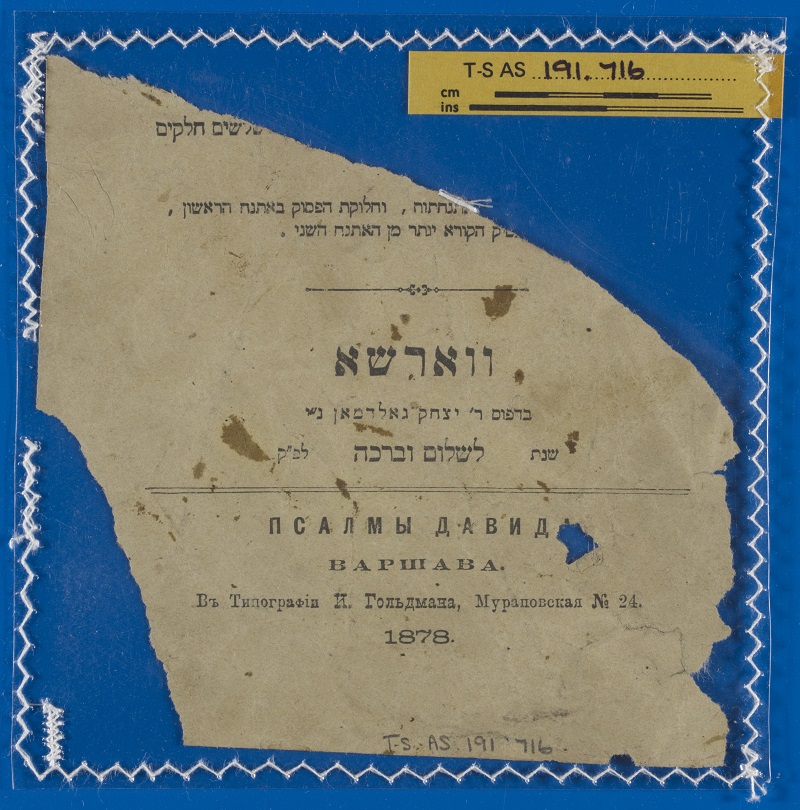
A small scrap numbered T-S AS 191.716 is a torn title page of a book. Its Hebrew is expectedly verbose, self-advertising and highlighting the presumed benefits of the edition. In contrast, the Russian laconically states only ‘Psalms of David’, the location of the printing house and the year. The presence of Russian is important: it allowed the identification of the book by those who knew no Hebrew, e.g., officials or retailers, and proved the book’s legitimacy. Above the remaining part of the date on the verso, an edge of the letter ю is visible for those knowing what they are looking for: it is a trace of Дозволено цензурою (“Permitted by the censorship”). Lack of the place name on verso would mean that the authority granting approval was located in the same place as the printing press. Eighteenth- and nineteenth-century Hebrew printers of the Empire dutifully printed their Russian titles, but they were often sloppy to the degree of being illegible. In contrast, the title of this Warsaw 1878 edition of Psalms of David is neat, well-proportioned and grammatically correct.
Isaac Goldman
Isaac Goldman the Printer (1812/3–1888)1 -- not to be confused with his namesake the Lithuanian Jewish poet Isaac Goldman, two generations his junior -- was born in Ясеновка (Jasionówka), a village of Белостокская область, ex-Prussian territory ceded to Russia after the Treaty of Tilsit. Expediently positioned on the trade routes, the settlement had Magdeburg rights, but later dwindled into insignificance. Thanks to the economic boom of the nineteenth century, towards the end of Goldman’s lifetime its population increased more than six-fold and Jasionówka became a proper shtetl. During WWII, it was depopulated and shrunk again, this time without the Jews.
The biographers assume that Goldman acquired his initial education at home. Already as a child, he must have been proficient in German, Polish and Russian. Married at the age of fifteen, he moved to Białystok, and later in 1836 to Warsaw, where he was hired as corrector, an assistant to the censor and a sworn translator on behalf of the government. The work for which his services were required, was plentiful: in the same year, at the suggestion of I.B. Levinzon, there appeared a decree requiring a total revision of all Jewish books in circulation. Censors’ assistants generally performed all the main tasks of directly reviewing and correcting the books and manuscripts, while censors validated their work with a final signature. Meticulous proofreading skills and thorough attention to detail were necessary for such a career. Equally important was understanding the logics and purpose of censorship.
Censorship controlling bodies, such as the Scholarly Committee of the Ministry of Public Education (Ученый комитет Министерства народного просвещения, 1818 – 1828), General Directorate of Censorship (Главное управление цензуры, 1828 – 1862), and Special Office of the Minister of Public Education (Особенная канцелярия министра народного просвещения, 1862 – 1863), all formed departments of the Ministry of Education and worked to promote enlightenment via secular schooling. A person of maskilic background, Goldman must have found these intentions natural: ultimately, Regulation on Jews (Положение о евреях, 1804), which defined government policy towards Jews up to the 1880s, was based on the ideas of G. R. Derzhavin and the European maskilim. The Jewish population was perceived in it as ‘backward’ and ‘retrograde’, to be ‘corrected’ and ‘improved’ through European-style education, supposedly allowing it to merge with the surrounding Christians. Close attention was paid to Jewish religious literature: it was to be purged of everything ‘superstitious’, ‘irrational’, contradicting the laws of the Empire, disrespectful to Christianity or royal authority. Printing an uncommented Pentateuch and Psalter without censorship approval was acceptable, since it was presumed that the Divine word in its pure form cannot do any harm. Yet every interpretation entailed problems, since even the wording of basic prayers could arouse questions, and texts such as the Talmud appeared particularly obscurantist and dangerous.
In his Warsaw jobs, Goldman rubbed shoulders with Jacob Tugendhold (1794–1871), who, together with his brother Wolf (1796–1864), exercised a profound effect on Jewish printing and education in the Empire. A person of serious traditional education complemented by secular studies, Jacob Tugendhold became an adviser to the government on Jewish matters in 1819. On the top of being constantly busy with organizing Jewish state education in Poland and managing community affairs in Warsaw, he was appointed censor of Hebrew publications and, from 1852, director of Warsaw’s Rabbinical Seminary. A year later, in 1853, Goldman was employed as a teacher of Hebrew, Aramaic and Talmud at this seminary, a position he held until the seminary’s dissolution.
The Rabbinical Seminary in Warsaw was anything but what one can imagine from its official name.2 Scholars still dispute whether a single graduate of that seminary ever became a rabbi; and consensus seems to be that none did.3 Apart from religious subjects, the seminary boasted extensive program of natural sciences, history, geography and languages. Yet many – in fact, almost all – actors of the local political and cultural scene were bound to be unhappy with its existence and Tugendhold’s activities: the traditionalists preferred heders to modern state-run schools, the Polish nationalists viewed every cooperation with the Russian administration as suspicious, and the partisans of the Haskalah denied any benefit from religious studies. For the progressivists, supporting enlightened absolutism felt excessively conservative and out of touch with the spirit of the time. The communities, on their hand, were more interested in their rabbis being competent in Talmud rather than in mathematics or French, and saw censorship as an intrusion into established customs and sacrilege against their age-old texts. As the contradictions became too many to be solved, the well-meant but unlucky institution closed its doors in 1863 (?), never to re-open. The life of Isaac Goldman entered a new stage.
As it happens, times were ripe for the shakeup of many organizations and many endeavours. The reforms of Alexander II triggered radical changes in the social life of the Empire – and across Europe. From 1 July 1862, Jews were allowed to open printing houses under the same conditions as other Russians. Publishing was no longer a privilege of a couple of official typographers but became a business like every other. Government cancelled the import tax previously levied on Jewish books printed in the Kingdom of Poland. A huge market of the Pale of Settlement was laid open, and entrepreneurs of the Western provinces, in particular Warsaw, stood up to the challenge. They used their proximity to the engineering centres to acquire advanced printing equipment, and invested in technical improvements.4 Low wages of local manual and intellectual workers helped decrease costs. As a result, Jewish printers started encroaching into even more territories, e.g., Central and Southern Europe, and even more languages, e.g., Polish and Russian. Their products represented excellent value for money, and they managed to drive Western Europe out from its position as the world centre of Hebrew and Jewish printing.
Goldman established his printing house in 1867 (?).5 In as far as finances and marketing were concerned, his starting point was not as advantageous as of many of his competitors. He was neither Romm nor Orgelbrand. Yet he possessed something equally valuable: experience. As a government employee and an insider of the censorship process, he had intimate knowledge of what the system expected, and how to deal with it. As a teacher, he understood what materials were most adequate for schooling process and what books could interest the students. Well-acquainted with earlier Western prints, he aimed at improving them by enriching content, supplying indexes, developing clear and user-friendly page layout. As a result, readers appreciated his books. Until today, they appear on Wikipedia pages as exemplary editions of classical Jewish texts.6 They are still photo-reprinted, notwithstanding having first appeared almost a century ago.7 The fact that Goldman’s print reached Egypt was, of course, a piece of fortune – and it was not.
The Cambridge University libraries combined, rich as they are, own less than a sixth of the book repertoire produced by Goldman.8 We lack a complete volume of the edition, from which T-S AS 191.716 originates, and many other Goldman psalters. Still, CUL’s collection is sufficient to get an idea about his printings. The staple income of a Hebrew publisher of early modernity always came from ruml-sforim (< ספרי רבנים ומלמדים), i.e., (rabbinic) educational texts: Torah, halakha and Midrash. Of those, our readers can enjoy five volumes of Pentateuch with Targum, Rashi and the commentaries of Meir Loeb b. Jehiel Michael Malbim (ed. 1876-1880), three volumes of Yalkut Shimoni with Zayit raʻanan (ed. 1876–1877), and Halakhot gedolot in the so-called Babylonian redaction with commentaries (ed. 1874). A variety of homiletic and chronological works are also available: Twelve Sermons by Nissim b. Reuben Gerondi (ca 1310–1375), (ed. 1875), Sefer nefuṣot Yehudah by Judah ben Joseph Moscato (ca 1530–1593) (ed. 1871), Sefer Yuḥasin ha-shalem by Abraham b. Samuel Zacuto (ca. 1450–1510) (ed. 1876), Shem ha-gedolim by Hayyim Joseph David Azulai (1724–1806) (ed. 1876), Megillat Taʼanit (ed. 1874), etc.
Among individual authors, Maimonides appears to be the best represented: Cambridge libraries have Sefer Moreh Nevukhim in Shmuel Ibn Tibbon’s translation with the commentaries by Shem Tov b. Joseph Falaḳuera, Profiat Duran and Isaac Abravanel (ed. 1872), Mishneh Torah with all the standard commentaries (1881–82, joint ed. by Orgelbrand and Goldman), Sefer ha-Mitsvot with its commentaries by Nahmanides, Megilath Esther ascribed to Isaac de Leon, Lev Sameach, Kinath Soferim etc. (ed. 1883). The ample presence of Maimonides may be due not only to the vagaries of the collections’ history, but also to the fact that Maimonides’ heritage took pride of place in the programme of the Rabbinical Seminary of Warszaw: it was studied there as a special subject. While teaching, Goldman must have been using these texts recurrently.
Several of Goldman’s printings in Cambridge evidence the publisher’s efforts of getting Jewish intellectuals acquainted with the Christian sources – and their own ancient history. In particular, in 1863 Goldman re-published the apocryphal books of Maccabees translated from Greek into Hebrew by Seckel Isaac Fränkel (1765–1835), and in 1884 – the Book of Ecclesiasticus (the Cambridge Genizah fragments were not yet discovered). Less usual for its subject matter appears Sefer Shiʻur ḳomah by Moses b. Jacob Cordovero (1522–1570) (ed. 1883) and Hamiluim oder Masbir Hachadasz: aramäisch-rabinisch-deutsches Wörterbuch: Ergänzung zu dem Hamasbir oder Aruch published in 1869. Like many maskilim, Goldman preferred ‘proper’ German to ‘vulgar’ Yiddish.
The editions preserved elsewhere are even more varied: they included at least one calendar, a textbook of Russian in Yiddish, multiple textbooks of Hebrew, translations of German and Russian poetry into Hebrew, textbooks of arithmetic, books on various applied scientific topics, not to mention the hidushim of many prominent rabbis of the region. Last but not the least, Goldman intended to publish a modern encyclopedia of general knowledge in Hebrew, called ‘Eshkol’, to be distributed in booklets to subscribers. Unfortunately, his death cut the venture short, and only six booklets saw the light of day.
Isaac Goldman died in 1888 in the 75th year of his life. A large crowd accompanied him in his last journey. The unpretentious gravestone avoids linguistic novelties or political messages of any kind.
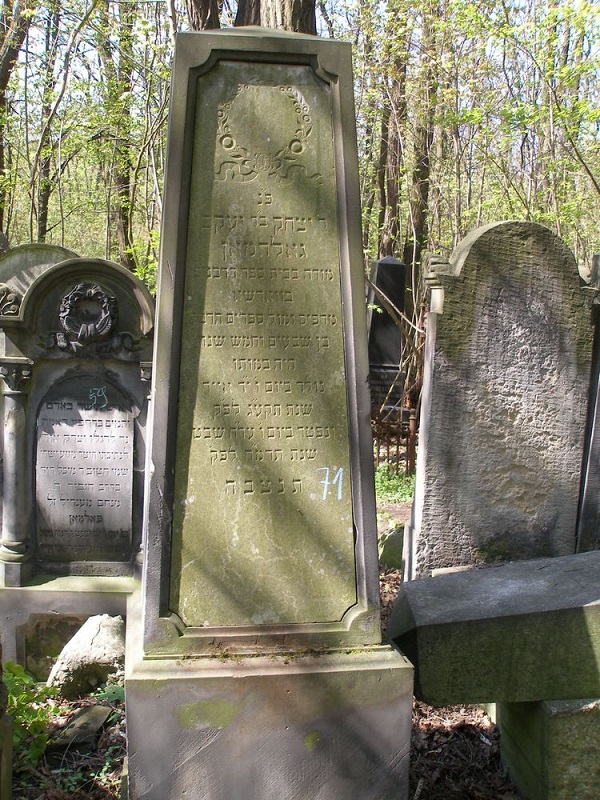
Goldman’s grave in the Warsaw Jewish cemetery9
A laconic eulogy in the local press stated:
Мурановская 24 11
Visualizing the practical setting of ambitious maskilic printing projects with their fine scholarship and wide-reaching intellectual pursuits, one inevitably drifts to the images of respectable bourgeois quarters with their well-organized households and neat offices. Nothing would be further from the truth. Google does show Muranowska Str. on the map of modern Warsaw, but it is yet another illusion. Neither its architecture nor even its location are those of Isaak Goldman’s times. The new Muranowska Str., a symbolic tribute to the past, shares with the old nothing but its name.
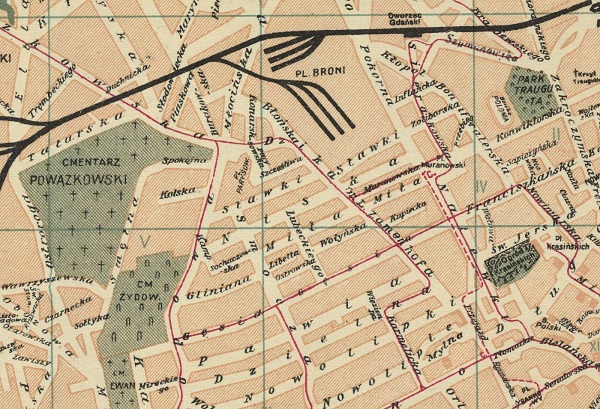
Historical map of northern Warsaw, showing the original Muranowska Str (top row, second grid section from the right)
Fortunately, the lack of immediate visual experience is somewhat compensated for by literature and photography. That is how the Nobel prize winner Isaac Bashevis Singer (1903–1991) described the area:
‘Those’ streets included Dzielna, Pawia, Gęsia, Miła, Niska, Stawki, Muranów Square, and above all Nalewki and Franciszkańska. There reigned an eternal panic (בהלה). Before the war, Jews traded from here with Vladivostok, Petropavlovsk and even with China. Here there were large enterprises packed with merchandise up to the ceiling. The rents in the area were high, because each apartment was a small enterprise. Indeed, no one could count the tiny factories that were located there. The din of passionately bargaining voices did not fade throughout the day, not even for a moment. On ‘those’ streets there were study houses and Hasidic shtiblechs as well, but they were invisible among the shops, workshops and factories that surrounded them. In ‘those’ streets, people did not walk, they ran, and even getting to the next street they ‘caught a tram’. Thousands of traveling salesmen supplied from here the goods to the most distant buyers. [...] Almost every apartment in ‘those’ streets was also a shop or a flophouse. Stocks of imported goods were constantly unloaded [.…]. It was here that one discussed the rise and fall of the stocks, commented on the exchange rates of foreign currencies, and wondered whether the pound sterling is going up or down. 12
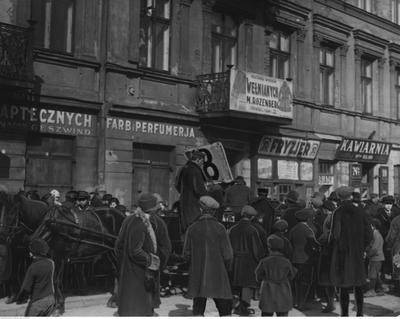
‘Those’ streets in the vicinity of Goldman's printing shop
As is clear from the above, Goldman’s printing shop was right in the heart of ‘those’ streets, and the amazing variety of its products must have been born amidst the frenzy of competition and existential need to excel, described by Bashevis so vividly. Having formed part of the newly globalized trade, Goldman reached out if not to China, than certainly to many parts of the Empire, and eventually – indirectly -- even to Cairo. Yet this brilliant success was only one part of the story.
Bashevis Singer, himself an inhabitant of a ‘good’ street, as most well off people were, tended to romanticise poverty, and if the turmoil, agitation and hectic enthusiasm of ‘those’ places did not escape him, much of the misery hidden behind the modern facades did. Luckily, he was not the only one to leave a description of the neighbourhood. Muranowska Str was the next street to the north, parallel to the Miła Str (lit. ‘Pleasant/Nice/Lovely Str’), a place immortalized in the poem of Władysław Broniewski (1897–1962)13:
|
Ulica Miła wcale nie jest miła. Ulicą Miłą nie chodź, moja miła. Domy, domy, domy surowe, trzypiętrowe, czteropiętrowe, idą, suną, ciągną się prosto, napęczniałe bólem i troską.
W każdym domu cuchnie podwórko, w każdym domu jazgot i turkot, błoto, wilgoć, zaduch, gruźlica. Miła ulica. Miła ulica.
Na ulicy Miłej jest zakład pogrzebowy, obok jatka i sklepik z balonem wody sodowej, naprzeciwko - klinika lalek, naprawa parasoli... Perspektywa rzeźnickim nożem przecina oczy. To boli.
Jezdnią, po kocich łbach, trąbiąc pędzi pogotowie, to pod trzynastym powiesił się fryzjer, który miał źle w głowie: czytał powieści detektywne, chciał zostać aktorem, wiecznie coś deklamował albo śpiewał piskliwym tenorem.
Moja mila, ty nie wiesz, jak źle ulicą Miłą błąkać się we mgle, niosąc bezdomne marzenie i nie napisany wiersz. No, powiedz, miła czy wiesz?
To nie była dusza fryzjera, to był anioł prawdziwy, jak z trampoliny wzbił się z ulicznej perspektywy, leciał na białych skrzydłach i ponad każde podwórko rzucał bawiącym się dzieciom jedno bialutkie piórko, dzieci piórka anielskie rączkami chwytały, chwytały, a wtedy z ciemnego nieba spadł śnieg anielsko biały. Ludzie, ludzie, ludzie wieczorni gorliwie dreptali piechotą, anioł zniknął, dzieci posmutniały, zostało błoto.
W nocy nad ulicą Miłą - gwiaździsta ospa. W nocy na ulicy Miłej - rozpacz. i wiele troski zobaczysz, mila, przechodząc miastem, ale najwięcej na ulicy Miłej pod numerem trzynastym. W suterenie pogrzeb. Niedobrze. Na parterze płacze wdowa po fryzjerze. Na pierwszym piętrze - plajta, komornik. A na drugiem służąca otruła się ługiem. Na trzecim piętrze rewizja - mundurowi, tajniacy. Na czwartym czytają "Kurier Warszawski" - "poszukiwanie pracy". Na poddaszu dziewczyna dziecko dwudniowe zabiła. Miła ulica. Ulica Miła.
Na ulicy Miłej ani jedno drzewko nie rośnie, na ulicy Miłej - w maju! - ludzie nie wiedzą o wiośnie, ale cały rok hula perspektywa łysych gazowych latarni, łbem waląc w mur cmentarny. Moja miła, ja tą ulicą nie chodzę, choćby mi było po drodze. Nawet kiedy do ciebie się śpieszę, nie idę ulicą Miłą, bo kto wie, czy się tam nie powieszę
|
Lovely Street is not lovely at all. Avoid the Lovely Street, my love. Houses, houses, gloomy houses, three-storey, four-storey, they walk, they stride, they march straight bloated with pain and worry.
Every backyard stinks, clamour and clatter in every house, mud, mould, stuffiness, phthisis. Lovely street. Lovely street.
On Lovely Street there is a funeral home next to a slaughterhouse and a seller of soda water, opposite to a doll clinic, “Umbrellas Repaired” … This view cuts your eyes with a cleaver. It aches.
An ambulance rushes on the cobblestones, it was under number thirteen that a barber hanged himself, he was wrong in the head: he read detective novels, wanted to become an actor, always recited something or sang with a squeaky tenor.
My lovely, you don’t know how bad is wandering along the murky Lovely Street, bearing a homeless dream or an unwritten poem. Do you, honey?
His soul was not of a barber, he was a real angel, as from a springboard he rose above on white wings, and over every yard he threw a white feather to the playing kids. The kids grabbed the angel’s feathers with their tiny hands and the angel-white snow fell from the dark sky. People, people, evening people, eagerly trotted around, the angel disappeared, the kids became sad, there remained mud.
Night over the Lovely Street is a starry smallpox. Night on Lovely Street is despair. You will see much trouble, love, as you pass through the city, but most of it on Lovely 13. The funeral is in the basement. No good. The barber’s widow is crying on the ground floor. On the first floor, it is bankruptcy and bailiff. And on the second a maid poisoned herself with lye. On the third floor, there is a search, uniformed and undercover agents. On the fourth, they readWarsaw Courier job adverts. In the attic, a girl killed her two-day-old child. Lovely street. What a Lovely Street.
Not a single tree grows on the Lovely Street, in May people are unaware of spring, All year round only bald gas lanterns bang their heads against the cemetery wall. My beloved, I don't walk this street, even if it is on my way. Even hurrying to see you I'm not walking along the Lovely Street, for who knows if I will not hang myself there.
|
Muranowska 24 did not make it to textbooks, but like Miła 13, it housed private lodgings, food shops, two orthodox houses of prayer and a chocolate manufacturer 'Mary'.
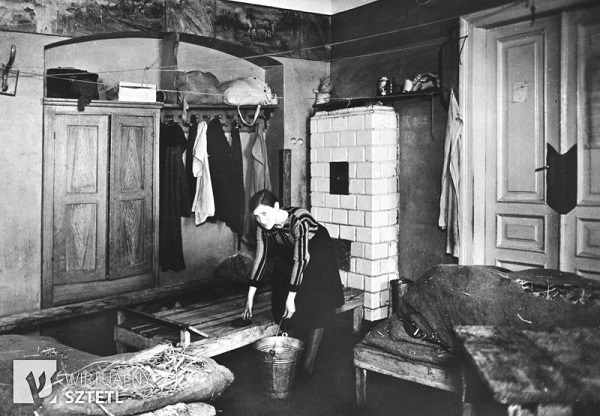
A prayer house on Muranowska 24, interwar period (?)14
Located on the edge of the ghetto, Muranów Square became the scene of the major battle of the Warsaw Ghetto Uprising in April 1943. The Jewish Military Union (,יידישע מיליטערישע פֿאראייניקונג Żydowski Związek Wojskowy) located its headquarters and arsenal on Muranowska Str, and since the fighting was fierce, most of the surroundings were reduced to rubble.
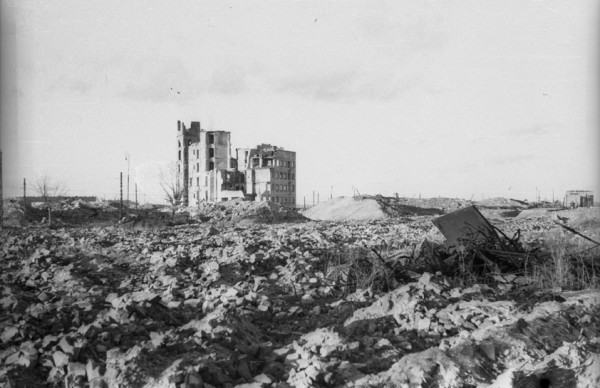
Image of demolished streets taken from Muranów Sq. towards the northeast
I looked for a picture of the precise place, but found none. This shot was made from Muranów Sq. towards the northeast; the standing buildings are on the corner of Przebieg and Muranowska streets.15
The house on Мурановская 24, just meters away from the Square, was judged unfit for reconstruction and demolished. T-S AS 191.716 remains a tiny memorial to the determination, diligence and piety of its occupants.
Footnotes
1 Unfortunately, a complete and up-to-date biography and a list of Goldman’s editions remain desiderata. In the secondary sources, there are multple discrepancies in dating for even the major events of Goldman’s life; they should be dealt with by the professional historians. I hope they may find the material worthy of their attention.
For general background see: B. Weinryb, "Zur Geschichte des Buchdruckes und der Zensur bei den Juden in Polen," Monatsschrift für Geschichte und Wissenschaft des Judentums 77 (N. F. 41) (1933, 4 (Juli/August )): 273-300; Jacob Shatzky, Geshikhte fun yidn in Varshe, 3 vols. (New York, 1947–1953); Chaim D. Friedberg, Toledot ha-defus ha-‘ivri be-Polanya, Tel-Aviv: 19502, 111– 112; Yitsḥak Kornfeld-Dagani, “Le-Korot hotsa’at ha-sefer ha-‘ivri be-‘ir Varshah,” Perakim: Bit‘on ha-Akademyah ha-‘Ivrit be-Amerikah (1966): 347–363; Дмитрий Аркадьевич Эльяшевич, Правительственная политика и еврейская печать в России, 1797-1917 гг. (Санкт-Петербург; Иерусалим: Гешарим, 1999); Kenneth B. Moss, “Printing and Publishing after 1800”, The YIVO Encyclopedia of Jews in Eastern Europe, http://yivoencyclopedia.org/article.aspx/Printing_and_Publishing/Printin....
2 On the school’s intended organization and functioning see: [n.a], Plan ogólny zaprowadzenia szkoły rabinów w Warszawie, Warsaw, 1826; on various aspects of its activity see Janusz Baranowski, “Szkoła Rabinów w Polsce,” Stowarzyszenie Historyczne Żydów Miasta Częstochowy, 17.06.2018, http://shz-mykwa.pl/index.php?option=com_content&view=article&id=311:201... Ewa Kula, "Warszawska Szkoła Rabinów w protokołach posiedzeń rady wychowania publicznego w latach 1845–1850," in Szkolnictwo, opieka i wychowanie w Królestwie Polskim od jego ustanowienia do odzyskania przez Polskę niepodległości: 1815–1918, ed. by Hanna Markiewiczowa and Iwona Czarnecka, Warsaw: Wydawnictwo Akademii Pedagogiki Specjalnej, 2016, 144-156.
3 See Agnieszka Jagodzińska, "Warszawska szkoła rabinów w świetle źródeł misyjnych," Kwartalnik Historii Żydów 2014, 1 (249): 142–161; ead., "Reformers, Missionaries, and Converts: Interactions between the London Society and Jews in Warsaw in the First Half of the Nineteenth Century," in Converts of Conviction: Faith and Scepticism in Nineteenth Century European Jewish Society, ed. by David B. Ruderman, Berlin: De Gruyter, 2018, 9-25.
4 E.g., S. Orgelbrand created new typefaces, which were used in his and other typographies.
5 According to others, in 1864.
6 E.g, http://en.wikipedia.org/wiki/Kuzari.
7 E.g., Cambridge libraries own a 1956 reprint of Sefer seder ha-dorot by Jehiel b. Solomon Heilprin (ca. 1660-ca. 1746), a chronological work containing a list of tannaim and amoraim, reworked by Naftali b. Avraham Maśkil le-Etan (1829-1897), and a 1958-9 reprint of Kuzari by Judah ha-Levi in Yehudah ibn Tibon’s translation with commentaries Ḳol Yehudah by Judah b. Joseph Moscato (ca. 1530-ca. 1593) and Otsar Neḥmad by Israel b. Moses Zamość Halevi (1700–1772).
8 This is a rough estimate. The precise number of Goldman’s books is not easy to establish, since some of them were published without explicitly stating his name, some under other names, and some may still be unknown to researchers.
9 Source: http://he.wikipedia.org/wiki/%D7%A7%D7%95%D7%91%D7%A5:Grave_of_Izaak_Gol....
10 Source: Eliyahu Tziprin, “Rabbi Yitzchak Goldman,” Knesset of Israel, Book III (1888), 643.
11 Some of Goldman’s books mention the address Muranowska 22.
12 The essay “Every Jewish Street in Warsaw Is a Town in Itself” was published in the New York newspaper פֿאָרווערטס Forverts (Forward) on July 2, 1944 under the pen name Yitzhak Warszawski. Source: http://www.nli.org.il/en/newspapers/frw/1944/07/02/01/article/26/?srpos=...
13 Translating the poem was a forced choice: I searched for a ready translation, but found none. Apparently, the communist sympathies of Broniewski prevented his work from being translated -- although not from being appreciated by many, including his political opponents. My translation is almost literal; the original is rhymed.
14 Source: http://sztetl.org.pl/pl/miejscowosci/w/18-warszawa/112-synagogi-domy-mod.... Nr hip. 2195.
15 Author: Józef Jerzy Karpiński ("Jerzy"). Image ownership: Muzeum of Warsaw Uprising. Source: http://polishjews.yivoarchives.org/content/city-vistas-and-muddy-roads-gallery-where-jews-lived-0
Cite this article
Krivoruchko, Julia. 2022. "A Tale of a Torn Title Page: T-S AS 191.716." Taylor-Schechter Genizah Research Unit. doi:10.17863/CAM.99634.
If you enjoyed this Fragment of the Month, you can find others here.
Contact us: genizah@lib.cam.ac.uk
The manuscripts in this article are part of the Cairo Genizah Collection in Cambridge University Library. To see more items from this collection visit: https://cudl.lib.cam.ac.uk/
